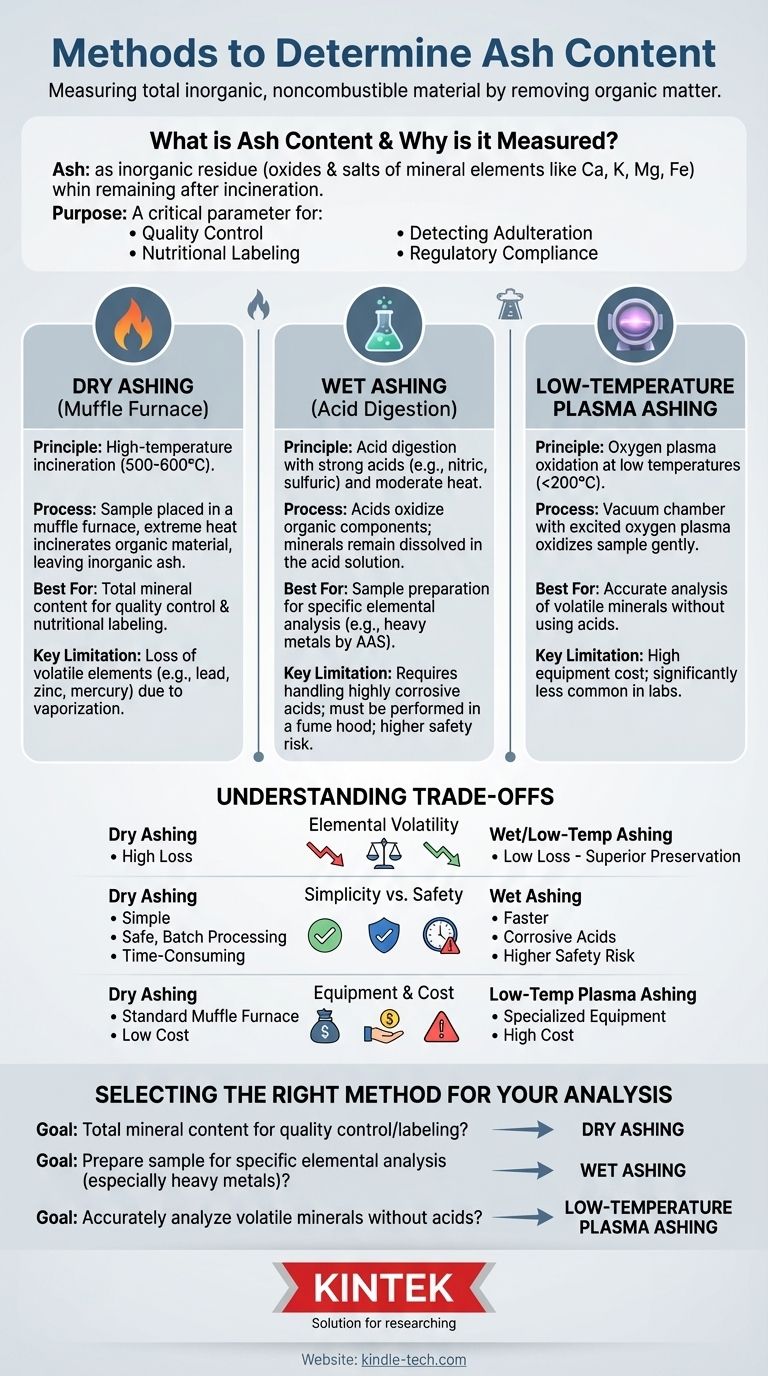The primary methods for determining ash content are dry ashing, wet ashing, and low-temperature ashing. These techniques are used to measure the total amount of inorganic, noncombustible material in a sample by removing all organic matter. The best method depends entirely on the nature of your sample and your ultimate analytical goal.
Choosing an ashing method is not about finding the "best" one, but about aligning the technique with your objective. The core decision is whether you need a simple measure of total mineral content or if you must preserve specific volatile elements for further analysis.

What is Ash Content and Why is it Measured?
Defining Ash
Ash is the inorganic residue that remains after a sample has been completely incinerated or oxidized. This residue consists of the oxides and salts of the mineral elements (like calcium, potassium, magnesium, and iron) present in the original sample.
The Purpose of Ash Analysis
Measuring ash content is a critical parameter in quality control and regulatory compliance. It serves as an indicator of the total mineral content in foods, animal feed, and other materials. This analysis helps verify nutritional labeling, detect adulteration, and ensure a product meets its specified quality standards.
The Core Methods of Ash Determination
Dry Ashing (Muffle Furnace Method)
This is the most common and straightforward method for determining total ash content.
The sample is placed in a high-temperature muffle furnace, typically heated to between 500 and 600°C. The extreme heat incinerates all organic material, leaving only the inorganic ash behind.
Wet Ashing (Acid Digestion)
Wet ashing, or acid digestion, uses a different principle to remove organic matter.
Instead of high heat, this method employs strong acids (like nitric or sulfuric acid) and moderate heat to oxidize the organic components. It is not typically used for total ash determination but is essential for preparing samples for specific elemental analysis. The minerals are left dissolved in the acid solution, ready for techniques like atomic absorption spectroscopy (AAS).
Low-Temperature Plasma Ashing
This is a more specialized and gentle technique for removing organic matter.
It uses a vacuum chamber where oxygen is excited into a plasma state. This reactive oxygen plasma oxidizes the sample at much lower temperatures, usually below 200°C.
Understanding the Trade-offs
Elemental Volatility
The high temperatures of dry ashing can cause certain mineral elements (like lead, zinc, and mercury) to vaporize, leading to inaccurate results if you need to measure them later.
Wet ashing and low-temperature ashing operate at lower temperatures, making them far superior for preserving these volatile elements.
Simplicity vs. Safety
Dry ashing is generally safe, simple to perform, and allows for many samples to be processed simultaneously. However, it can be very time-consuming, often taking several hours.
Wet ashing is often faster but requires careful handling of highly corrosive acids and must be performed in a fume hood. It carries a higher risk of chemical exposure if not done correctly.
Equipment and Cost
A muffle furnace for dry ashing is standard equipment in most analytical labs. In contrast, low-temperature plasma ashers are significantly more expensive and less common, reserved for specialized applications where minimizing mineral loss is paramount.
Selecting the Right Method for Your Analysis
A clear understanding of your end goal is the most important factor in choosing a method.
- If your primary focus is determining the total mineral content for quality control or nutritional labeling: Dry ashing is the standard, most reliable, and cost-effective choice.
- If your primary focus is preparing a sample for specific elemental analysis (especially heavy metals): Wet ashing is the necessary method to ensure minerals remain in solution and are not lost to volatilization.
- If your primary focus is accurately analyzing volatile minerals without using acids: Low-temperature plasma ashing is the ideal, though more specialized, technique.
Ultimately, selecting the correct method ensures the accuracy and relevance of your analytical results.
Summary Table:
| Method | Key Principle | Best For | Key Limitation |
|---|---|---|---|
| Dry Ashing | High-temperature incineration (500-600°C) in a muffle furnace | Total mineral content for quality control & nutritional labeling | Loss of volatile elements (e.g., lead, mercury) |
| Wet Ashing | Acid digestion with strong acids (e.g., nitric acid) and moderate heat | Sample preparation for specific elemental analysis (e.g., heavy metals) | Requires handling corrosive acids; safety risks |
| Low-Temperature Plasma Ashing | Oxygen plasma oxidation at low temperatures (<200°C) | Accurate analysis of volatile minerals without acid use | High equipment cost; less common in labs |
Need expert guidance for your ash content analysis?
Choosing the right ashing method is critical for accurate results. At KINTEK, we specialize in providing the precise lab equipment—from robust muffle furnaces for dry ashing to specialized systems for wet digestion—that your laboratory needs for reliable quality control and elemental analysis.
Let our experts help you select the ideal solution for your specific samples and analytical goals. Contact us today to discuss your application and ensure your lab's success!
Visual Guide

Related Products
- 1400℃ Muffle Oven Furnace for Laboratory
- 1700℃ Muffle Oven Furnace for Laboratory
- Laboratory Muffle Oven Furnace Bottom Lifting Muffle Furnace
- 1800℃ Muffle Oven Furnace for Laboratory
- 1400℃ Laboratory Quartz Tube Furnace with Alumina Tube Tubular Furnace
People Also Ask
- What are the different types of laboratory furnaces? Find the Perfect Fit for Your Application
- What is the difference between muffle furnace and air oven? Choose the Right Tool for Your Thermal Process
- What is done by ashing in muffle furnace? A Guide to Precise Inorganic Content Analysis
- What is the difference between a muffle furnace and a normal furnace? Ensuring Sample Purity with Indirect Heating
- What is the difference between a box furnace and a muffle furnace? Choose the Right Lab Furnace for Your Application



















